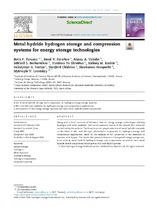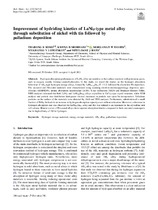The impact of active and passive thermal management on the energy storage efficiency of metal hydride pairs based heat storage
| dc.contributor.author | Nyamsi, Serge Nyallang | |
| dc.contributor.author | Tolj, Ivan | |
| dc.date.accessioned | 2021-10-18T12:26:37Z | |
| dc.date.available | 2021-10-18T12:26:37Z | |
| dc.date.issued | 2021 | |
| dc.identifier.citation | Nyamsi, S. N., & Tolj, I. (2021). The impact of active and passive thermal management on the energy storage efficiency of metal hydride pairs based heat storage. Energies, 14(11). https://doi.org/10.3390/en14113006 | en_US |
| dc.identifier.issn | 1996-1073 | |
| dc.identifier.uri | https://doi.org/10.3390/en14113006 | |
| dc.identifier.uri | http://hdl.handle.net/10566/6925 | |
| dc.description.abstract | Two-tank metal hydride pairs have gained tremendous interest in thermal energy storage systems for concentrating solar power plants or industrial waste heat recovery. Generally, the system’s performance depends on selecting and matching the metal hydride pairs and the thermal management adopted. In this study, the 2D mathematical modeling used to investigate the heat storage system’s performance under different thermal management techniques, including active and passive heat transfer techniques, is analyzed and discussed in detail. The change in the energy storage density, the specific power output, and the energy storage efficiency is studied under different heat transfer measures applied to the two tanks. | en_US |
| dc.language.iso | en | en |
| dc.publisher | MPDI | en_US |
| dc.subject | Heat storage | en_US |
| dc.subject | Metal hydrides | en_US |
| dc.subject | Heat management | en_US |
| dc.subject | Energy storage efficiency | en_US |
| dc.subject | Energy storage density | en_US |
| dc.title | The impact of active and passive thermal management on the energy storage efficiency of metal hydride pairs based heat storage | en_US |
| dc.type | Article | en_US |




